
There’s no doubt which site is the highlight of Athens. The Acropolis Hill crowns the sprawling city as a constant reminder of its celebrated past and the uninterrupted inhabitation of the city through the millennia.
But Athens is not just a place to admire dead history. Though still emerging, modern art is making its mark in the city’s cultural map. The unification of archaeological sites in the city center has created a three kilometer pedestrian promenade, which connects the ancient sites around the Acropolis Hill with the neighborhoods around it. The cities unmissables include the Acropolis Hill, the Archaeological museum, the pedestrian centre, Benaki, Cycladic, Islamic and Jewish Museums, as well as the oldest stadium in Europe, the Panathenaic.
The city is filled with festivals, galleries and contemporary cultural events that reach their peak during the summer season, when the Greek Festival (June-August) is in full swing and a series of foreign and Greek productions of classic and experimental theatre, music, dance, concerts and opera take over the capital. Modern viewings are presented in ancient theatres, while classical theatre is played in innovative ways. There are some seriously good shows every summer that will satisfy every taste. For all information concerning the festival, including programme and ticket booking, check the festival’s excellent website at www.greekfestival.gr, or pick up a copy of the programme from the festival’s ticket office at 39 Panepistimiou Street (Metro: Panepistimio).
You can start your walk from Dionyssiou Areopagitou Street, across from the Temple of Zeus in Makriyanni, and follow the cobblestone path around the Hill.

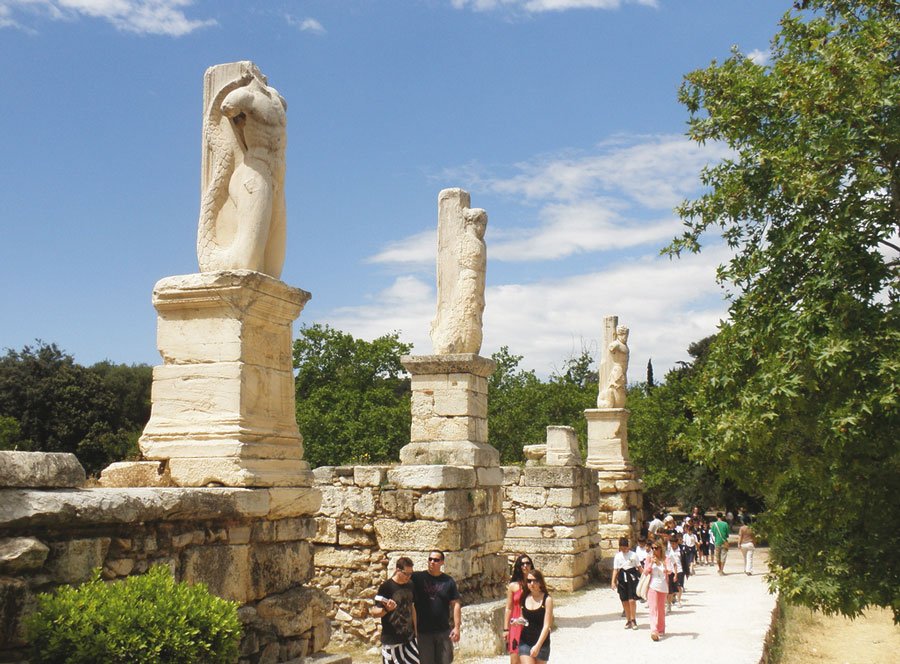
The ancient promenade
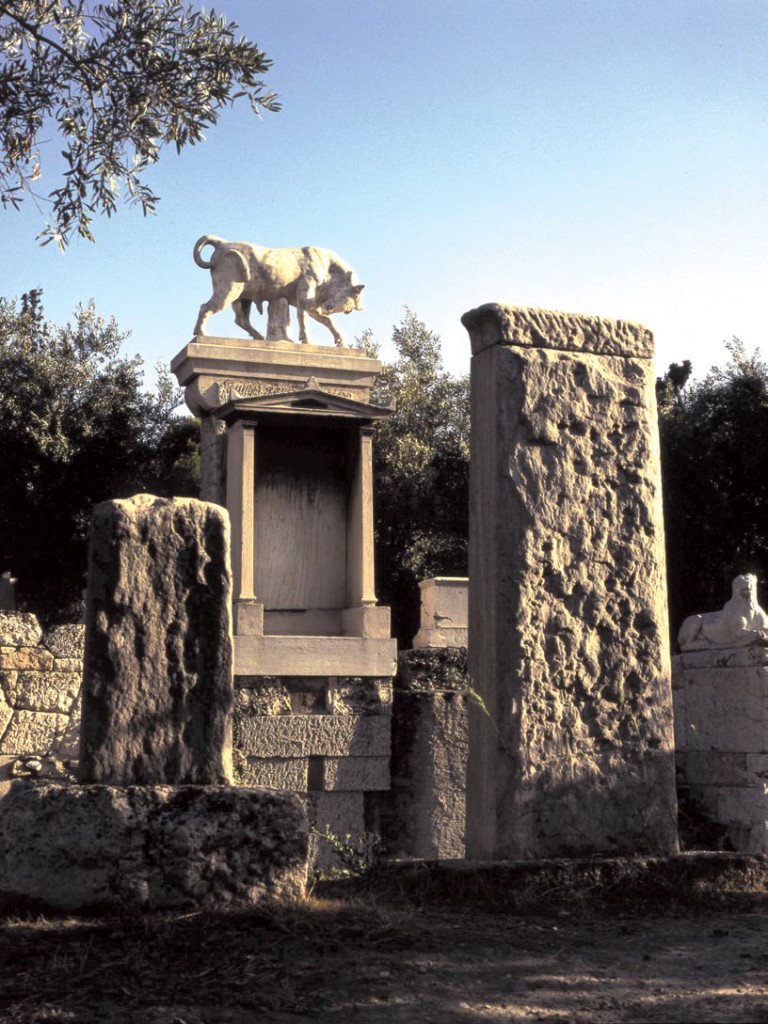
The most enjoyable way to get a fuller picture of Athens’s historic centre is to stroll through the ancient ruins and narrow streets surrounding the Acropolis. The recent plan to unify the archaeological sites around the Acropolis Hill by pedestrianizing the streets and restoring monuments and listed buildings in the area has met with such success that Athenians have almost forgotten how it was before. The great thing about this route is that you can plan it any time of the day; either in daytime by pausing to visit sites on the way, or in the evening, as part of your walk around the city centre. A good starting point would be from Dionysiou Areopagitou Street, right across the Temple of Zeus in Makriyanni and then follow the cobblestone path around the Hill. On your way, you see the Acropolis Hill and the Parthenon, the ancient Odeon of Herod Atticus, Filopappou Hill, and further away, the hills of Imittos and Parnetha. The street is then renamed Apostolou Pavlou and you reach the picturesque square of Thissio, one of the liveliest neighbourhoods of the city, with cafés and restaurants lining the streets. High up on Ermou Street you find the vast Keramikos cemetery, were Athenians were buried from 3,000 BCE until the 6th century CE. Continuing your walk you end up in Monastiraki from where you can either follow the route towards Gazi and Keramikos, or walk towards neighbouring Plaka.
High up on Ermou Street you find the vast Kerameikos ancient cemetery, were Athenians were buried from 3,000 BCE until the 6th century CE.
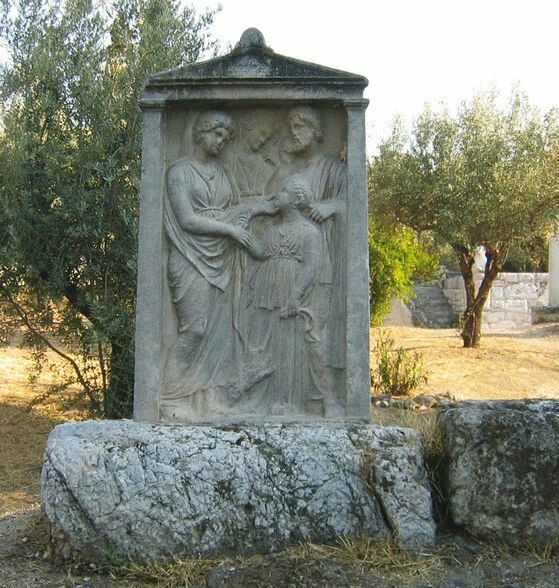
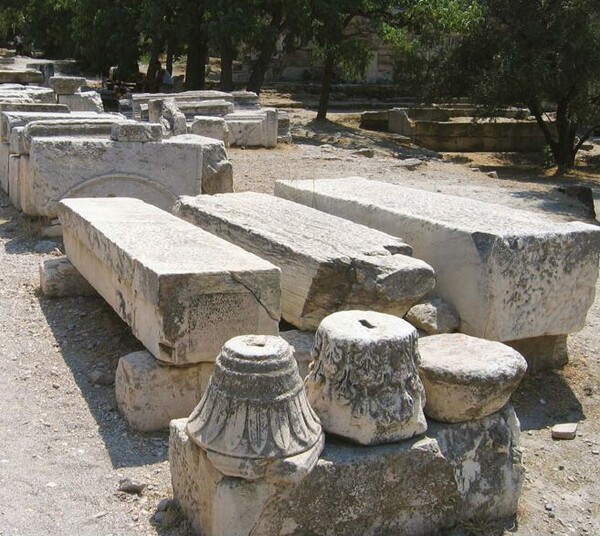
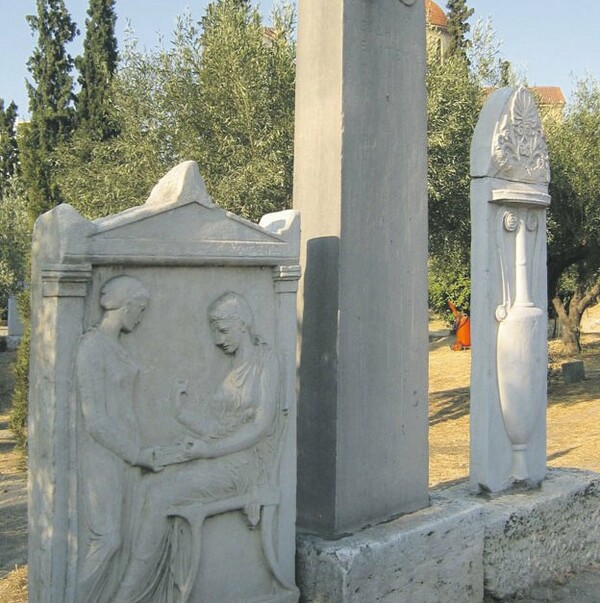
Attalos Arcade

The Attalos Arcade (Stoa of Attalos) is a two-storey arcade built by king Attalos, King of Pergamon around 150 BC. It is thought to have been an ancient shopping center that housed 21 shops on each of its floors. The Arcade, now serving as the sites’ museum, forms part of the Ancient Agora, an extensive area which housed, among others, administrative buildings, shops, schools, law courts, prisons, theatres even the city mint that produced its silver coins. The Agora was the political, cultural and religious center. Athenians would gather on a daily basis, not only to buy and sell their goods, but also to learn the news, to criticize the government, to debate issues or simply to gossip. This is where philosophers like Socrates spent his days debating different issues. It is dominated by three monuments: the Attalos Arcade, the Temple of Hephaisteion and the Byzantine Church of the Holy Apostles. The Arcade stood for nearly five hundred years until it was burnt down in AD 267 by the Heruli tribe. It was rebuilt by the American School of Classical Studies between 1953 and 1956 on the original foundations using the original materials and is now used as a museum which showcases all the finds from the Agora. Some of the museum’s most interesting artifacts include the klepsydra, a water clock used for timing speeches and ancient ballot boxes for voting and children’s toys. Last year, the museum opened its first floor, for the first time after 30 years, following extensive restoration. The visitor will now have the opportunity to admire about 56 artefacts dating from the post-Classical to the Roman periods, some of which have never been exhibited before. The room will exhibit models of buildings, portraits of the Roman Agora and the warehouse which houses the findings from the surrounding area. At the same time, models of the surrounding area will allow the visitor to visually connect the Arcade with other nearby sites, such as Pnyka – the area where Athenians gathered to listen to the speeches of their leaders. The statues exhibited will be in organised in six loose groups, instead of the usual linear style. Among the groups, one will include artefacts of the post-Classic and Hellenistic period (4th and 3rd centuries BC), another will include Roman copies of Greek classical works of the 1st and 2nd centuries AD, a third will have Roman portraits of the same period, and another will exhibit columns with busts of public officials.
- Ancient Agora, Monastiraki, entrance from Adrianou Street / Ticket: €12 for the combo ticket that includes the Acropolis / Hours: Mon to Sun 08:00-17:00, every Monday the Museum is open 11:00-17:00 / Metro: Monastiraki
Syntagma, Acropolis & Plaka

Monastiraki Square at night
These three neighbourhoods constitute the core of Athens and are the main destination for anyone visiting the city and with good reason. The white marbles of the Parthenon tower over the historic centre of the city and around the Hill, the old neighbourhoods with their small houses and quiet side-streets offer relief from the noise and heat of the modern city. These neighbourhoods, the most photographed areas of the city, are the ideal places to start your walk when you fly into town.
 Syntagma square is the centre of the city. Formerly a palace, the Parliament building and the square in front of it have been the ground of many important political events in the country’s history. At the front courtyard there’s the Monument to the Unknown Soldier, paying tribute to the country’s dead soldiers, as well as the colourful Evzones – traditionally dressed guards. Every hour the changing of the presidential guards gathers many spectators who enjoy seeing men in kilts performing a perfectly synchronized ceremonial.
Syntagma square is the centre of the city. Formerly a palace, the Parliament building and the square in front of it have been the ground of many important political events in the country’s history. At the front courtyard there’s the Monument to the Unknown Soldier, paying tribute to the country’s dead soldiers, as well as the colourful Evzones – traditionally dressed guards. Every hour the changing of the presidential guards gathers many spectators who enjoy seeing men in kilts performing a perfectly synchronized ceremonial.
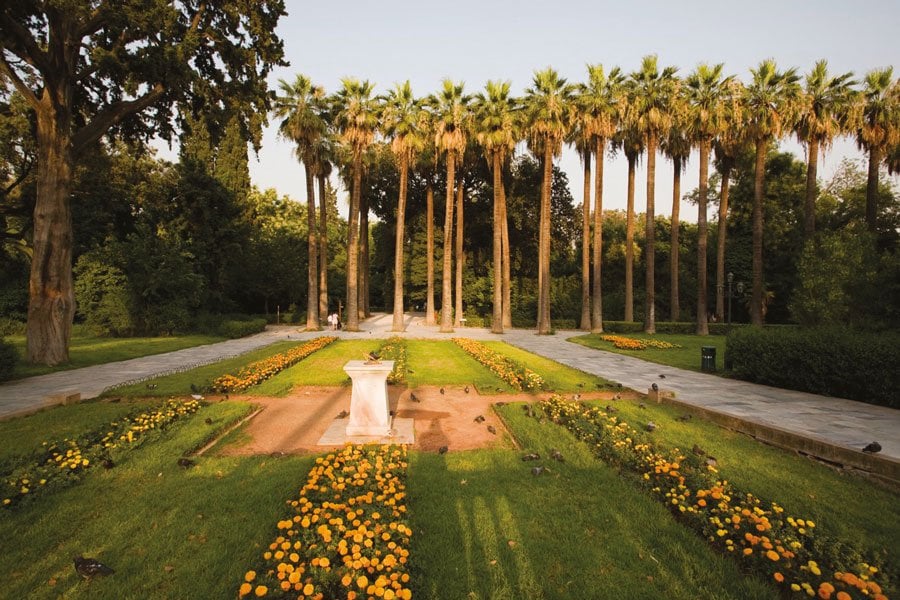 Behind the Parliament building, the National Gardens offer a much needed patch of green and shadow in the capital. They are open from sun dawn to sun dusk and are accessible from Vasilisis Amalias avenue or Irodou Attikou Street. The Gardens host about 47,000 trees and plants, a botanical museum, small ponds with fish and ducks, as well as a café. At the southern side of the Gardens, you’ll find Zappeio Mansion, a donation of the wealthy Konstantinos Zappas in the 19th century, used today as a conference centre. During the day, Zappeion serves as a getaway from the noise and the traffic of the city, while in the evening it’s a meeting point for those heading to the café, cinema or bar-restaurant located in the adjacent buildings.
Behind the Parliament building, the National Gardens offer a much needed patch of green and shadow in the capital. They are open from sun dawn to sun dusk and are accessible from Vasilisis Amalias avenue or Irodou Attikou Street. The Gardens host about 47,000 trees and plants, a botanical museum, small ponds with fish and ducks, as well as a café. At the southern side of the Gardens, you’ll find Zappeio Mansion, a donation of the wealthy Konstantinos Zappas in the 19th century, used today as a conference centre. During the day, Zappeion serves as a getaway from the noise and the traffic of the city, while in the evening it’s a meeting point for those heading to the café, cinema or bar-restaurant located in the adjacent buildings.
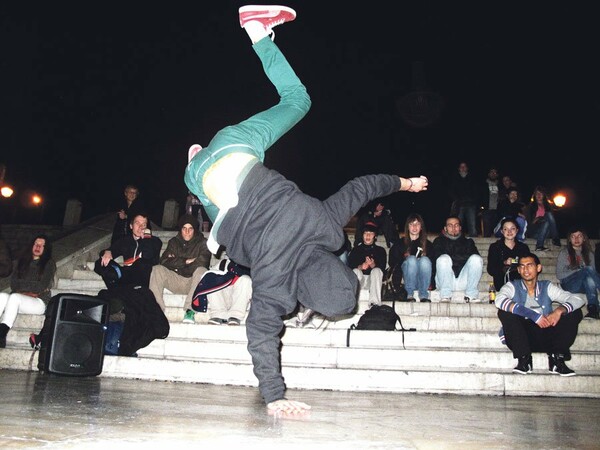
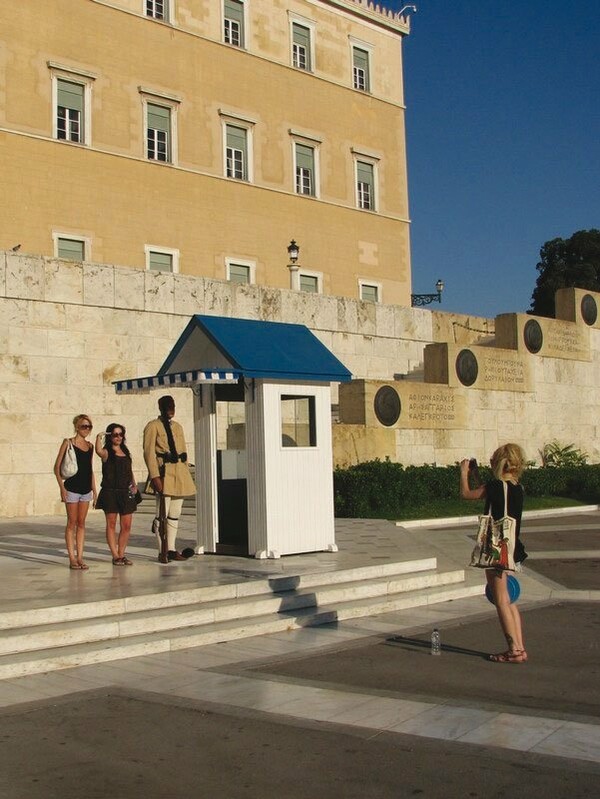
The historic neighbourhood of Plaka embosoms the Acropolis Hill on all sides. Together with Monastiraki, they contain an endless variety of historic sites from different eras and civilisations –Pre-historic, Greek, Roman, Ottoman. Apart from its touristy side, Plaka is one of the few remaining neighbourhoods of the city that retain their unique neoclassical architectural style of old Athens. A walk through its winding streets is a glimpse in the way people lived and interacted with one another in the geitonia (neighbourhood) when everyone knew their neighbours and a daily stop at the café was a ritual. Perched right under the Acropolis is the quaint Anafiotika quarter, a quiet area with whitewashed Cycladic-style houses. These small houses were built by stone masons from the Cycladic island of Anafi in the mid-19th century, who arrived in Athens to work at the construction of the royal palace after independence. The beautiful white Church of Aghios Georgios marks the area from afar. Walking towards the train lines, you enter Monastiraki, the biggest open-air museum in the country. On Adrianou Street is the Ancient Agora, the centre of government in ancient Athens, while the amazing Temple of Hephestos built in 449 BCE, is the best preserved Doric temple in Greece. At the corner of Eolou and Adrianou Streets you find the Roman Agora and the impressive, octagonal Tower of the Winds that is said to have been a sundial and a water clock. As an impressive proof of the successive civilisations that inhabited the area, inside the Roman Agora you also find the beautiful Fethiye Djami, one of the few surviving examples of Ottoman mosques in Athens. The second one is Tsistaraki Mosque, found right on Monastiraki Square, which has been renovated and is now housing the Kyriazopoulos Folk and Ceramic Museum, with a collection of over 800 pieces of ceramics from all over the country.
Poetic justice: Walking through Plaka, at the junction of Iperidou, Kekropos and Sotiros Streets, right across Nefeli Hotel, there is a boarded-up crumbling house, outside of which you may encounter the ‘poet’, an English-speaking man who has used the boards sealing the house as a canvas to make his humorous remarks on Greece’s political and economic woes. His comment reads: “Wanted, dead or alive, Greek Prime Minister, no qualifications or brains required, only well-connected. Permanent position, five-star salary, tax-free offshore, apply online anytime.”
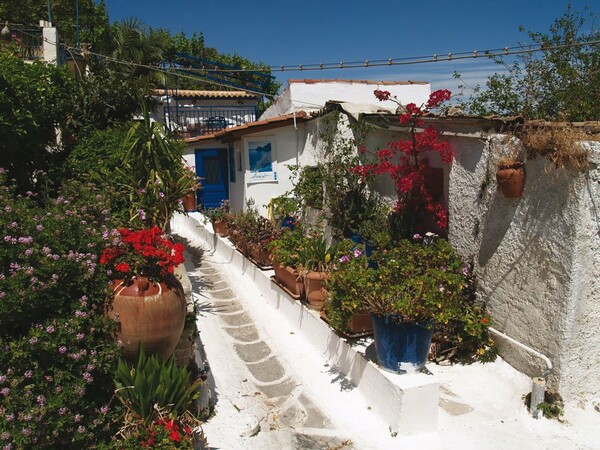
The Acropolis Hill & the Parthenon
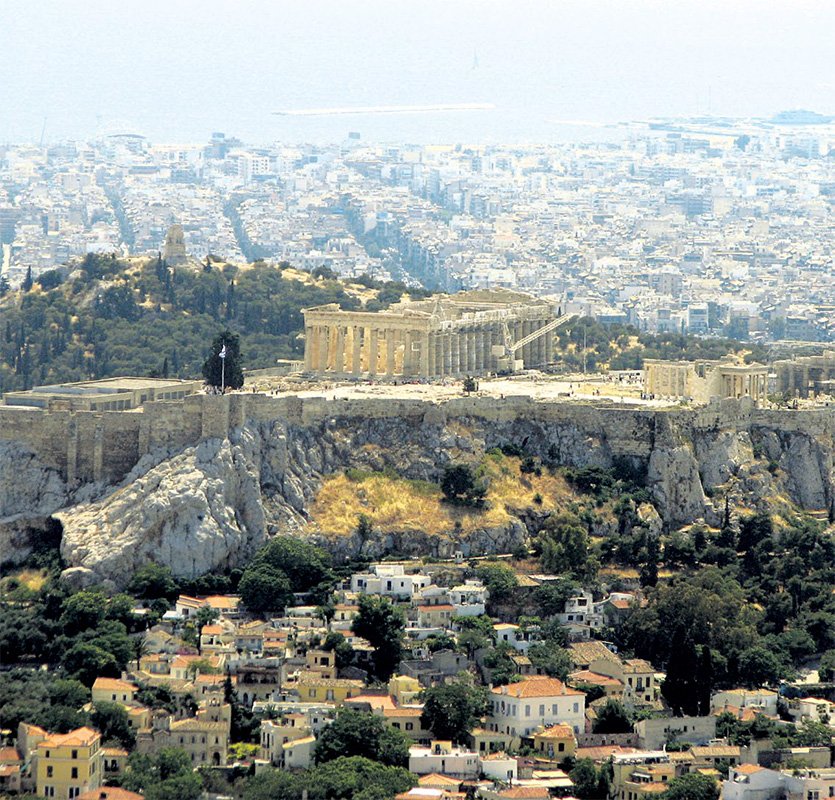
Against all odds, the Acropolis Hill (entrance from Dionysiou Areopagitou Street) dominates the Athenian skyline in a remarkable way. Climbing the 70-metre Hill the history of the ancient city unfolds before you starting from Neolithic times, when the first findings are dated. Its flat top is due to the numerous landfills that have accommodated construction of fortifications and temples since the Mycenaean era.
The first building you encounter when you enter is the Propylea (437-432 BCE), the monumental entrances to the area, made from marble of mount Pendeli to mark the entrance to the religious complex. Its function was to receive and assemble the visitors and it was built in the Doric order with few Ionic columns supporting the roof of the central wing. The architect of the project Mnesikles who began building right after the main construction of the Parthenon was completed in 437 BCE. However, five years later the Peloponnesian war erupted and construction had to stop. At the southwest is the elegant Temple of Athena Nike (426-421 BCE) of Ionian order, designed by the other wonder child of architecture, Kallikrates. It is said that it housed the statue of Athena Nike, which was made of wood and held a helmet in the left hand. Since it had no wings, the temple acquired the name Apteros Nike (wing-less victory). This way, Athenians thought, victory would never leave the city. The Erechtheion (421-c405 BCE) is known for its spectacular six female figures functioning as columns, the Caryatids. Possibly named after the women of the city of Karyes, the originals have been transferred into the Acropolis museum. It is a complicated temple. The idea was to accommodate the radically uneven ground on the site, and to avoid disturbing sacred shrines that pre-existed, like the altars to Poseidon and Hephaestus, or the spot where Poseidon hit the Acropolis with his trident. Other elements that needed to be included were the sacred olive tree, well containing sea water, the tomb of Kekrops, and the Pandrosion sanctuary.
The Parthenon (447-438 BCE), built for Virgin (Parthenos) goddess Athena, was made to honour her after she won over the city in a confrontation with Poseidon. Built atop an older temple destroyed by the Persians, Athenians spared no expense in rebuilding a sanctuary of unrivalled craftsmanship. The marble structure of Doric order was 13.72 metres high and 69.50 metres long. Its famous architects, Iktinos and Kallikrates, used marble from the nearby mount Penteli throughout the building for the first time in such constructions. The building was meat to impress with the first glance and so it did, as visitors entered the Acropolis from Propylea and saw it in three quarter view. Its main function was to house the colossal statue of Athena that was made by Phedias out of gold and ivory.
The topic of the sculpted decorations was the myths regarding goddess Athena and the Persian defeat by Athens. All artwork, supervised by the sculptor Phedias, was completed by 432 BCE. The decoration of the Parthenon combines the Doric metopes and triglyphs on the entablature, with the Ionic frieze on the walls of the cella. They depict the Gigantomachy on the east side, the Amazonomachy on the west, the Centauromachy on the south, and scenes from the Trojan War on the north.
The value of the Parthenon lies, among other things, in the fact that at the time it was built, it epitomised the ideals Athenian society had developed during Pericles’s Golden Age: Democracy, accuracy through mathematics, aesthetics, and focus on the individual.
Acropolis Museum

The much talked about Acropolis Museum celebrated five years of operation in June. All antiquities formerly  crammed in the small museum atop the namesake hill were transported during 2007 in a mammoth-sized operation. The last exhibits were placed into their new positions in April 2008. The building, designed by Swiss architect Bernard Tschumi and Greek architect Mihalis Photiades, is made out of cement, stainless steel and glass, with spacious galleries. According to the architects, the idea behind the structure was to keep it solemn and simple, in an effort to focus attention on the exhibits, rather than the building itself.
crammed in the small museum atop the namesake hill were transported during 2007 in a mammoth-sized operation. The last exhibits were placed into their new positions in April 2008. The building, designed by Swiss architect Bernard Tschumi and Greek architect Mihalis Photiades, is made out of cement, stainless steel and glass, with spacious galleries. According to the architects, the idea behind the structure was to keep it solemn and simple, in an effort to focus attention on the exhibits, rather than the building itself.
 The exhibition rooms house the most important artefacts of the classical period, as well as other treasures that were previously kept in storage for lack of space. The museum has divided its roughly 4,000 artefacts in five collections: The finds from the slopes of the Acropolis Hill, antiquities from the archaic period, the classical period, the post-classical era and the Roman period.
The exhibition rooms house the most important artefacts of the classical period, as well as other treasures that were previously kept in storage for lack of space. The museum has divided its roughly 4,000 artefacts in five collections: The finds from the slopes of the Acropolis Hill, antiquities from the archaic period, the classical period, the post-classical era and the Roman period.
Some of the most emblematic ancient Greek antiquities are displayed: The archaic Kouroi (male statues) and Kores (female statues), a vast number of pottery, marble sculptures of maidens and athletes, the Parthenon frieze and all its surviving parts. Visitors will also have a chance to admire a collection of artefacts dug out during the excavation process on the ground floor and inspect the ancient city-beneath-the-city. Archaeologists uncovered ancient roads, houses, bath houses and workshops dating between 3,000 BCE-1,200 BCE, all of which can now be examined through a glass floor that extends from the outside area to the main hall. The route one follows forms a spiral pathway leading from the ground floor where the archaic artefacts are exhibited upwards towards the Parthenon marbles and back down through the Roman era.
The top floor houses the Parthenon frieze which is displayed in its original, 2,500-year-old full-length entirety, 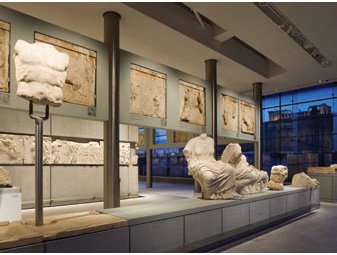 placed at the same angle as it did when it was on its original location, to maximise its effect on the viewer. The pieces missing from the frieze, famously known as the Elgin Marbles, have been replaced by duplicates. Greeks have been very vocal in requesting the originals back from the British Museum where they have been housed since Lord Elgin hacked them off the Parthenon in 1801.
placed at the same angle as it did when it was on its original location, to maximise its effect on the viewer. The pieces missing from the frieze, famously known as the Elgin Marbles, have been replaced by duplicates. Greeks have been very vocal in requesting the originals back from the British Museum where they have been housed since Lord Elgin hacked them off the Parthenon in 1801.
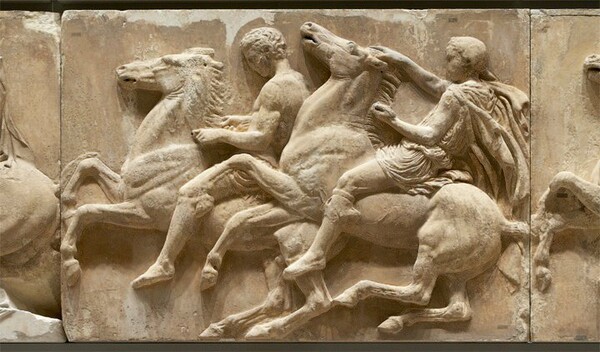
Don’t forget to visit the top floor café and restaurant for the best view in town. Visitors can book tickets online or buy them directly at the museum booth. Tourist groups roll in early, so try to be there before 8am.
- Entrance from Dionysiou Areopagitou, Makriyanni, Tel: +03 210 9241043, Tue-Sun 08:00-20:00, Fri until 22:00 / Mon closed / Entrance: €5 / Fri: Restaurant open till midnight / www.theacropolismuseum.gr
Jewish museum
Housed in a beautiful 19th century mansion, the Jewish museum traces the long history of the Romaniote and Sephardic Jewish communities in Greece, starting from the 3rd century BCE, through WWII and the present day. The vast majority of Greek Jews were killed in concentration camps during the WWII. Initially established in 1977, it collected jewellery, rare books and publications, textiles and domestic and religious artefacts in an effort to study preserve and exhibit all aspects of the lives of Greek Jews. As the collection grew, the museum’s activities expanded both in research and study of the Greek Jews and publishing. The exhibit moved to new grounds and the initial collections were enriched with added artefacts. The ground floor exhibits religious artefacts from synagogues that have closed down and ritual textiles dating from the 14th-19th centuries CE. A collection of items used in everyday and religious life are showcased next to costumes, photographs and documents. The photographic archive, consisting of original black-and-white or colour pictures as well as printed copies and slides, offers an invaluable glimpse at the everyday life of Greek Jews in various cities of the country.
- 39 Nikis, Plaka, Tel: +30 210 3225582, Hrs: Mon-Fri 09:00-14:30, Sun 10:00-14:00, Tickets: €5 / Metro: Syntagma.
Centre of Folk Art & Tradition
Experience the traditional way of Greek life in this quaint little mansion, created to preserve old-school Greek arts such as embroidery, needlework, traditional costume creation and pottery. The house was the residence of folklorist Angeliki Hatzimihali (1895-1965) and showcases object of Greek craftsmanship like embroideries and musical instruments, as well as an impressive library with books on Balkan folk art and crafts.
- 6 Hatzimihali Angeliki, Plaka, Tel: +30 210 3243972, Hours-Central building: Tue-Sun 09:00-14:00 / The Mosque: Mon, Wed, Thu, Fri, Sat, Sun: 09:00-14:00 / Bathhouse of the Winds: Mon, Wed, Thu, Fri, Sat, Sun: 09:00-14:30 / The Building at 22 Panos Str: Tue-Sun 09:00-14:30 / Tickets: €2 / Metro: Syntagma
Museum of Greek Folk Art
Dedicated to Greek folk art, like embroidery, ceramics, shadow-theatre and wood-carvings, as they developed  from the 17th century onwards, this amazing museum is housed in four different annexes. The main building (17 Kydathineon Street), houses the main collection of traditional costumes, silverware, embroidery, engraving and stone sculpture, as well as the amazing “Painted Chamber” by Theofilos Chatzimichail (1860-1934), a classical example of naïf art that once decorated the official chamber of a house on Lesvos Island (Mytilini).
from the 17th century onwards, this amazing museum is housed in four different annexes. The main building (17 Kydathineon Street), houses the main collection of traditional costumes, silverware, embroidery, engraving and stone sculpture, as well as the amazing “Painted Chamber” by Theofilos Chatzimichail (1860-1934), a classical example of naïf art that once decorated the official chamber of a house on Lesvos Island (Mytilini).
The old Tzirdaraki Mosque (1 Areos Street), houses the fine Kyriazopoulou pottery collection. The third venue is the Bathhouse of the Winds (8 Karystou Street), the only public bath of Athens surviving today, dating to the first period of Ottoman rule (1453-1669). While the collection which will be housed there is being prepared, one can visit the venue itself and explore its amazing labyrinth architecture. Last but not least, the building at 22 Panos Street is housing an exhibition titled: “Men and Tools. Aspects of Labor in Pre-industrial Society.”
Recently the museum opened a shop (45 Adrianou Street, Monastiraki), featuring tasteful replicas of embroidery, shadow puppets, children’s toys, jewelry, scarves, books and decorative objects, inspired by the museum’s rich collection.
- 17 Kydathineon, Plaka, Tel: +30 210 3229031, Hours: Tue-Sun 09:00-1400 / www.melt.gr / Metro: Syntagma
Museum of Greek Popular Instruments
 Greek music lovers will be enthused with the exhibit of 1,200 popular music instruments dating from the 18th century offering a glimpse in the variety of music sounds. The museum displays about half of the instruments forming the Anoyanakis Collection, which were selected on the criterion not only of their aesthetic but also of their ethnological and musicological interest. The remaining instruments are available for research and for travelling exhibitions and for occasional exhibitions of a special nature. The collection is spread over three floors and divided into four sections, according to the material that is made to vibrate, bearing tongue-twisting names such as membranophones, aerophones, chordophones and idiophones.
Greek music lovers will be enthused with the exhibit of 1,200 popular music instruments dating from the 18th century offering a glimpse in the variety of music sounds. The museum displays about half of the instruments forming the Anoyanakis Collection, which were selected on the criterion not only of their aesthetic but also of their ethnological and musicological interest. The remaining instruments are available for research and for travelling exhibitions and for occasional exhibitions of a special nature. The collection is spread over three floors and divided into four sections, according to the material that is made to vibrate, bearing tongue-twisting names such as membranophones, aerophones, chordophones and idiophones.
1-3 Diogenous, Plaka, Tel: +30 210 3254119, 3250198, Hrs: Tue, Thu-Sun 10:00-14:00, Wed noon-18:00, Entrance: Free / Metro: Monastiraki.
Ilias Lalaounis Jewelry Museum
 This is a private museum established by accomplished Greek jeweler Ilias Lalaounis to showcase the history and art of jewelry-making from ancient times. There are enough jewelry items here to create a new gold-rush, with visitors admiring about 4,000 items designed by the museums’ founder. Each collection has a different theme: One is inspired by the art, archaeology and anthropologic findings of prehistoric Europe and Greece, another is influenced by the Arabic, Celtic and Iranian art and there’s even a collection influenced by technology, astronomy and biology.
This is a private museum established by accomplished Greek jeweler Ilias Lalaounis to showcase the history and art of jewelry-making from ancient times. There are enough jewelry items here to create a new gold-rush, with visitors admiring about 4,000 items designed by the museums’ founder. Each collection has a different theme: One is inspired by the art, archaeology and anthropologic findings of prehistoric Europe and Greece, another is influenced by the Arabic, Celtic and Iranian art and there’s even a collection influenced by technology, astronomy and biology.
- 12 Kallisperi & Karyatidon, Makrigianni, Tel: +30 210 9221044, Hrs: Mon, Thu-Sat 09:00-16:00, Wed 09:00-21:00, Sun 11:00-16:00, Tickets: €4, free Wed 15:00-21:00, Sat 09:00-11:00 / http://www.lalaounis-jewelrymuseum.gr / Metro: Akropoli
Numismatic Museum
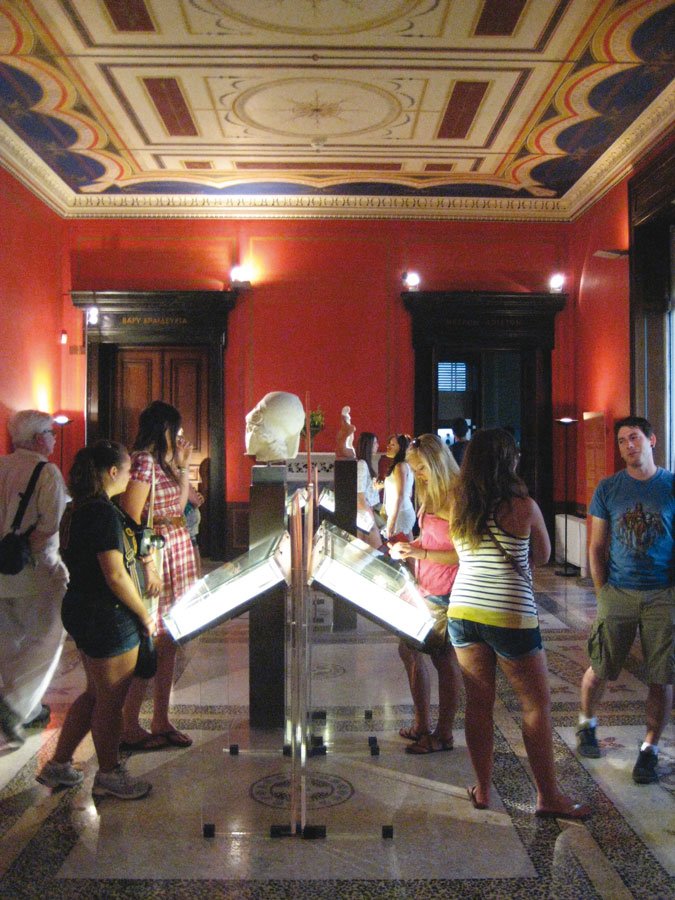 A massive collection of ancient coins found in Greece from antiquity through the Byzantine and modern times, is housed in a impressive building which used to be the house of German archaeologist Heinrich Schliemann. One gallery is dedicated to the famous archaeologist, exhibiting personal papers and collections, while the others exhibit different type of coins found all over Greece. A famous item is the “Coin hoard from Myrina”, a vase containing 149 silver coins from Aegina. The museums’ outdoor café, apart from being one of city’s best kept secrets, offers a quick respite after a long day.
A massive collection of ancient coins found in Greece from antiquity through the Byzantine and modern times, is housed in a impressive building which used to be the house of German archaeologist Heinrich Schliemann. One gallery is dedicated to the famous archaeologist, exhibiting personal papers and collections, while the others exhibit different type of coins found all over Greece. A famous item is the “Coin hoard from Myrina”, a vase containing 149 silver coins from Aegina. The museums’ outdoor café, apart from being one of city’s best kept secrets, offers a quick respite after a long day.
- 12 Panepistimiou, Syntagma, Tel: +30 210 3643774, Hours: Tue-Sun 08:30-15:00, Tickets: €3 / http://www.nma.gr / Metro: Syntagma.
Full moon events: August’s full-moon always appears to be the largest of the year and Athenians have a unique way of celebrating it. Traditionally, the Ministry of Culture opens up dozens of archaeological sites and museums around the country, allowing visitors free entry and a chance to enjoy them under the moonlight. In addition to that, the ministry organizes several open-air concerts around town. Romantics take to the small hills around the Acropolis (Philopappou, Pnyka) as the idea of admiring the city and its past under the moon is unbeatable. As expected, most people are eager to enter the Acropolis Hill as the image of the Parthenon against a giant bright moon is a major crowd-puller – and makes for a great picture too. Others opt for the serene Temple of Poseidon in Sounio, as well as the ancient Keramikos cemetery. This year’s August falls on the 21st.
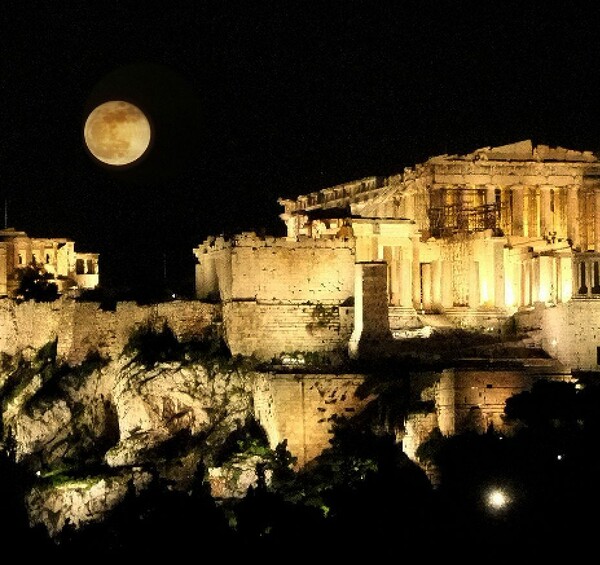


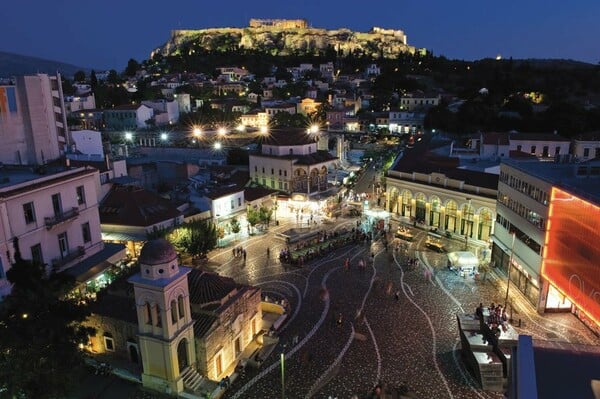

























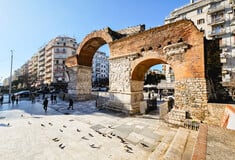

σχόλια